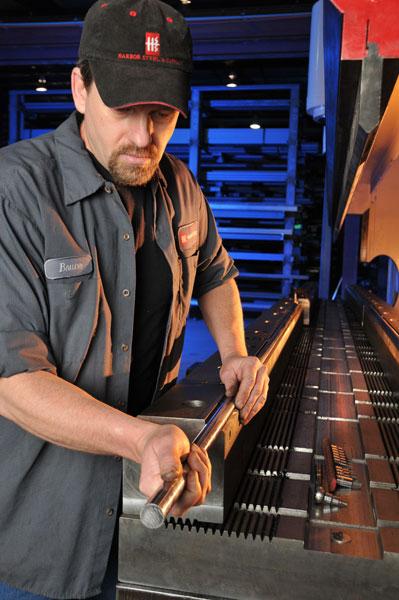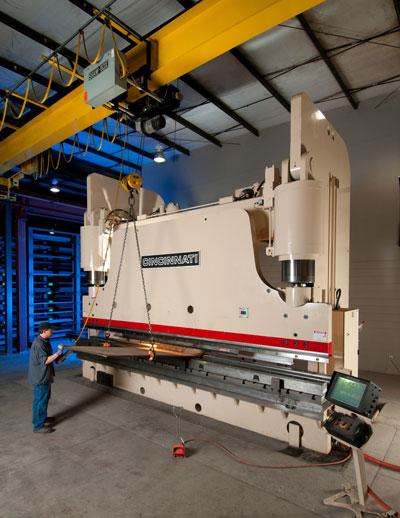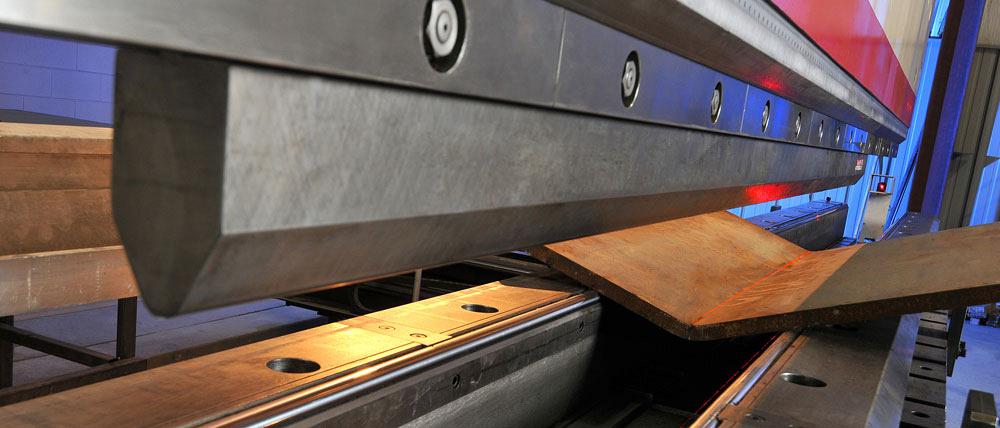Vice President
- FMA
- The Fabricator
- FABTECH
- Canadian Metalworking
Categories
- Additive Manufacturing
- Aluminum Welding
- Arc Welding
- Assembly and Joining
- Automation and Robotics
- Bending and Forming
- Consumables
- Cutting and Weld Prep
- Electric Vehicles
- En Español
- Finishing
- Hydroforming
- Laser Cutting
- Laser Welding
- Machining
- Manufacturing Software
- Materials Handling
- Metals/Materials
- Oxyfuel Cutting
- Plasma Cutting
- Power Tools
- Punching and Other Holemaking
- Roll Forming
- Safety
- Sawing
- Shearing
- Shop Management
- Testing and Measuring
- Tube and Pipe Fabrication
- Tube and Pipe Production
- Waterjet Cutting
Industry Directory
Webcasts
Podcasts
FAB 40
Advertise
Subscribe
Account Login
Search
Improving plate bending throughput
Press brake tooling options can help
- By Frank Rajk
- March 10, 2014
- Article
- Bending and Forming
As fabricators experience increased demand for heavy-plate forming services for the shipbuilding, structural steel, and heavy equipment industries, they need to improve thick-plate bending throughput.
For a long time fabricators created these forms made from high-tensile-strength materials using roll forming equipment and welding segments together. However, this method can be both time-consuming and costly.
Today fabricators are finding that forming these heavier materials on the press brake is more cost-effective and can produce a quality bend.
Forming on the press brake can be less labor-intensive, requiring fewer operators and offering faster setups, when compared to using older roll forming equipment. Because these plate bending jobs tend to be for smaller quantities, rather than thousands of parts at a time, setup time is critical to increasing throughput.
Press brakes also make it possible to produce a part in one or two sections, rather than the three or four sections roll forming that same part would necessitate. It is not uncommon to see tandem press brakes to be able to bend material up to 60 feet wide. Fewer sections requiring welding results in a much stronger final product compared to multisection weldments.
With the increased interest in bending on high-tonnage press brakes, the tooling industry has responded with the development of various tools designed for thicker-plate forming. These press brake tooling options offer different tool steel grades and new takes on tooling setup to help boost heavy-plate forming productivity.
Adjustable V Dies
One example is an adjustable V die, which can be designed to accommodate material thicknesses from 0.25 to 1.25 inches in a single hit, provided that the press brake has sufficient tonnage. It also can accommodate materials up to 2 in. thick for bump forming.
Adjustable V dies have a V opening that can be adjusted from 1 to 18 in. by 1-in. increments. The adjustable die can be changed quickly to accommodate different materials or thicknesses. Rather than changing out the die for each new bend, a single operator can adjust the V opening as needed by moving and then locking the side blocks into position. This greatly reduces changeover time and improves productivity.
Adjustable V die assemblies also can be configured to remain on the press permanently and function as a standard die holder, further reducing the amount of time operators spend setting up.
To reduce downtime for repairs, adjustable V dies are manufactured with induction-hardened work surfaces, making them capable of withstanding up to 200 tons per foot.

Figure 1 A press brake operator can slide out the hard chrome roller in this adjustable V die easily for quick maintenance work. The bottom tooling does not have to be removed.
In addition, hard chrome rollers and through-hardened inserts help reduce the tonnage required to perform a bend by up to 20 percent (see Figure 1). This gives the tooling better performance on high-tensile materials, such as AR400 steel, and significantly minimizes maintenance costs because the chrome rollers and through-hardened inserts can be replaced without removing the entire tool.
Available in different variations of adjustment and clamping options, adjustable V dies can be designed to suit specific operator needs. Choosing the right option will be dictated in large part by the frequency of changes to the opening when a different material or radius is required.
Manual clamping and adjustment may be adequate for press brake fabricators who rarely need to make changes to their setup. However, when more frequent changes are required, hydraulic clamping with manual adjustment may be a better option. Fabricators with large setups that require frequent changes may appreciate the convenience of hydraulic clamping with CNC automated adjustment capabilities.
Extraction Systems
Extraction-type press brake tools are used extensively in the energy market to manufacture high-tension hydro and wind towers. Because these parts get so large, the tooling is often equipped with extraction systems to assist in the removal of formed shells from the press.
The material being formed is so heavy that the plate often needs to be loaded into and unloaded from the press using cranes (see Figure 2), which can make it challenging to get material into position and later remove the part without damaging it or the tooling.
Some fabricators choose to build an extraction system on the side of the tool that pushes the part outside the press once the forming operation is complete. Hydraulic ball transfers that pop up to ease the part out can be used, or a nylon covering over the tooling can be used on top to help the system push the part out more easily, rather than dragging it over the tool itself. Either way, extraction systems help protect both the part and the tooling.
Replaceable Radius Tip Inserts
The loading and unloading of the top tooling also is a major concern because of its size and weight. For example, manufacturers that form hydro towers require very tall upper tools. To eliminate the changing of the entire top tool, they are manufactured with replaceable radius tip inserts, which can be changed easily.
Different radius tip sizes are used depending on the material thickness being formed. The stems of these punches are actually fairly narrow (1.25 to 1.5 in.), but are usually made of very high-tensile-strength tool steel to withstand plenty of pressure.
For example, changing out a 60-ft. upper punch would be a very time-consuming job to change the tooling itself. A better option is to make dovetail tip holder punches that can hold anywhere from a 0.25-in. tip radius to a 4-in. tip radius.
So for forming 90-degree shapes and U-channels, the fabricator could install large gooseneck top holders in the upper ram of the press and use replaceable slide-in radius tip inserts for different material thicknesses.

Figure 2 Because plate can be awkward to handle, many fabricators require cranes to assist with handling, which helps control the material while it is in the press brake.
Replaceable radius tip inserts are sectionalized, so a single operator can load and unload tips whenever a new radius is required—significantly reducing setup time. Typically, they also are ground and induction-hardened, making them able to withstand the heavy tonnage required to form some of these large parts.
Additional Considerations
To further improve throughput when bending thick-gauge material, fabricators should consider the following tips to help prevent costly setbacks such as tool breakage, increased stripping, distortion, and damage to parts:
Increase the die opening by choosing a punch with a thicker body, and be sure to calculate tonnage whenever the material thickness is outside the normal practice.
When working with thicker abrasive materials, consider heat-treat options, laser treatment, or induction hardening for tooling to minimize wear.
Increase the punch radius to disburse the load across a larger area. This will help reduce isolated tonnage on the punch tip.
Increase the die shoulder radius to further distribute the load and increase die life.
Forming thick, high-tensile-strength material on the press brake presents a variety of unique challenges to fabricators. Fortunately, more tooling providers now are offering better options for heavy metal fabrication. Choosing tooling that is designed specifically to handle the rigors of thick-plate processing can help significantly reduce setup time and minimize downtime related to maintenance and ultimately improve bending throughput.
About the Author
Frank Rajk
120 Van Kirk Drive
Brampton, ON L7A 1B1 Canada
651-286-6000
subscribe now

The Fabricator is North America's leading magazine for the metal forming and fabricating industry. The magazine delivers the news, technical articles, and case histories that enable fabricators to do their jobs more efficiently. The Fabricator has served the industry since 1970.
start your free subscription- Stay connected from anywhere

Easily access valuable industry resources now with full access to the digital edition of The Fabricator.

Easily access valuable industry resources now with full access to the digital edition of The Welder.

Easily access valuable industry resources now with full access to the digital edition of The Tube and Pipe Journal.
- Podcasting
- Podcast:
- The Fabricator Podcast
- Published:
- 04/16/2024
- Running Time:
- 63:29
In this episode of The Fabricator Podcast, Caleb Chamberlain, co-founder and CEO of OSH Cut, discusses his company’s...
- Trending Articles
Steel industry reacts to Nucor’s new weekly published HRC price

How to set a press brake backgauge manually

Capturing, recording equipment inspection data for FMEA

Are two heads better than one in fiber laser cutting?

Hypertherm Associates implements Rapyuta Robotics AMRs in warehouse

- Industry Events
16th Annual Safety Conference
- April 30 - May 1, 2024
- Elgin,
Pipe and Tube Conference
- May 21 - 22, 2024
- Omaha, NE
World-Class Roll Forming Workshop
- June 5 - 6, 2024
- Louisville, KY
Advanced Laser Application Workshop
- June 25 - 27, 2024
- Novi, MI



























